A Resilience Approach to Community-Scale Climate Adaptation
Abstract
1. Introduction
- (1)
- To build a catalog of community-scale climate adaptation measures that were being used, or had been used, in the agricultural sector in Ebonyi State;
- (2)
- To assess the effectiveness of these adaptation measures according to community residents, and the constraints/challenges of adopting them (as well as the benefits of adoption);
- (3)
- To understand which actions were being undertaken by which type of community groups (womens’ groups, farmer organizations, etc.).
1.1. Conceptual Framework
1.2. Study Area
2. Materials and Methods
Data Analysis
3. Results
3.1. Timeline Analysis
3.2. Climate Change Intervention Types
3.3. Climate Change Intervention Types by Group in the Communities
3.4. Interviewees’ Evaluation of Intervention Mechanism
3.5. Relationship between Size of Group, Duration of Group, and Type of Intervention
4. Discussion
5. Conclusions
Author Contributions
Funding
Acknowledgments
Conflicts of Interest
Appendix A
Appendix B
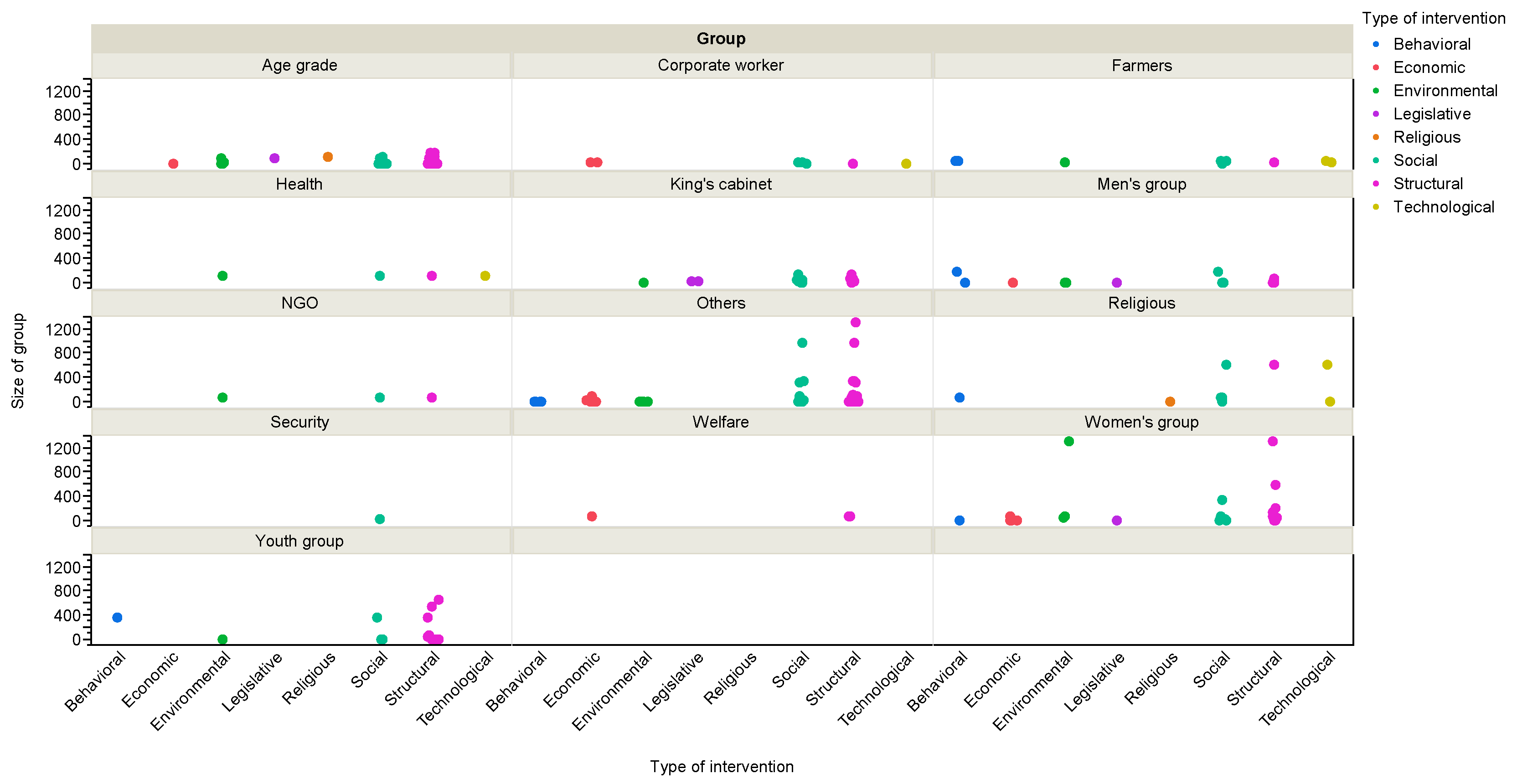
References
- Wang, G.; Alo, C.A. Changes in Precipitation Seasonality in West Africa Predicted by RegCM3 and the Impact of Dynamic Vegetation Feedback. Int. J. Geophys. 2012, 2012, 597205. [Google Scholar] [CrossRef]
- Ittersum, M.K.V.; Bussel, L.G.J.V.; Wolf, J.; Grassini, P.; Wart, J.V.; Guilpart, N.; Claessens, L.; Groot, H.D.; Wiebe, K.; Mason-D’Croz, D.; et al. Can sub-Saharan Africa feed itself? Proc. Natl. Acad. Sci. USA 2016, 113, 14964–14969. [Google Scholar] [CrossRef] [PubMed]
- Roudier, P.; Sultan, B.; Quirion, P.; Berg, A. The impact of future climate change on West African crop yields: What does the recent literature say? Glob. Environ. Chang. 2011, 21, 1073–1083. [Google Scholar] [CrossRef]
- Abiodun, B.J.; Lawal, K.A.; Salami, A.T.; Abatan, A.A. Potential influences of global warming on future climate and extreme events in Nigeria. Reg. Environ. Chang. 2013, 13, 477–491. [Google Scholar] [CrossRef]
- Obioha, E.E. Climate Change, Population Drift and Violent Conflict over Land Resources in Northeastern Nigeria. J. Hum. Ecol. 2008, 23, 311–324. [Google Scholar] [CrossRef]
- Harvey, C.A.; Rakotobe, Z.L.; Rao, N.S.; Dave, R.; Razafimahatratra, H.; Rabarijohn, R.H.; Rajaofara, H.; Mackinnon, J.L. Extreme vulnerability of smallholder farmers to agricultural risks and climate change in Madagascar. Philos. Trans. R. Soc. Lond. B Biol. Sci. 2014, 369, 20130089. [Google Scholar] [CrossRef]
- Warren, R.; Price, J.; Graham, E.; Forstenhaeusler, N.; VanDerWal, J. The projected effect on insects, vertebrates, and plants of limiting global warming to 1.5 degrees C rather than 2 degrees C. Science 2018, 360, 791–795. [Google Scholar] [CrossRef]
- Olabisi, L.S.; Liverpool-Tasie, S.; Rivers, L., III; Ligmann-Zielinska, A.; Du, J.; Denny, R.; Marquart-Pyatt, S.; Sidibé, A. Using participatory modeling processes to identify sources of climate risk in West Africa. Environ. Syst. Decis. 2017, 38, 23–32. [Google Scholar] [CrossRef]
- Frankenberger, T.; Mueller, M.; Spangler, T.; Alexander, S. Community Resilience: Conceptual Framework and Measurement Feed the Future Learning Agenda; Westat: Rockville, MD, USA, 2013. [Google Scholar]
- Jeans, H.; Thomas, S.; Castillo, G. The Future Is a Choice: The Oxfam Framework and Guidance for Resilient Development; Oxfam International: Oxford, UK, 2016. [Google Scholar]
- Béné, C.; Haddad, L.J.; Headey, D.D. Understanding resilience for food and nutrition security. In 2013 Global Hunger Index: The Challenge of Hunger: Building Resilience to Achieve Food and Nutrition Security; Welthungerhilfe; International Food Policy Research Institute, and Concern Worldwide: Bonn, Germany; Washington, DC, USA, 2013; pp. 18–31. [Google Scholar]
- Allen, K.M. Community-based disaster preparedness and climate adaptation: Local capacity-building in the Philippines. Disasters 2006, 30, 81–101. [Google Scholar] [CrossRef] [PubMed]
- Thomalla, F.; Downing, T.; Spanger-Siegfried, E.; Han, G.; Rockstrom, J. Reducing hazard vulnerability: Towards a common approach between disaster risk reduction and climate adaptation. Disasters 2006, 30, 39–48. [Google Scholar] [CrossRef]
- Aalst, M.K.V.; Cannon, T.; Burton, I. Community level adaptation to climate change: The potential role of participatory community risk assessment. Glob. Environ. Chang. 2008, 18, 165–179. [Google Scholar] [CrossRef]
- McIntosh, S.K. Beyond Chiefdoms: Pathways to Complexity in Africa; Cambridge University Press: Cambridge, UK; New York, NY, USA, 1999; p. x. 176p. [Google Scholar]
- Fals-Borda, O.; Rahman, M.A. Action and Knowledge: Breaking the Monopoly with Participatory Action Research; Apex Press: New York, NY, USA; Intermediate Technology Publications: New York, NY, USA; London, UK, 1991; p. viii. 182p. [Google Scholar]
- Rivers, L., III; Sanga, U.; Sidibe, A.; Wood, A.; Paudel, R.; Marquart-Pyatt, S.T.; Ligmann-Zielinska, A.; Olabisi, L.S.; Du, E.J.; Liverpool-Tasie, S. Mental models of food security in rural Mali. Environ. Syst. Decis. 2018, 38, 33–51. [Google Scholar] [CrossRef]
- Adger, W.N. Social and ecological resilience: Are they related? Prog. Hum. Geogr. 2000, 24, 347–364. [Google Scholar] [CrossRef]
- Berkes, F. Understanding uncertainty and reducing vulnerability: Lessons from resilience thinking. Nat. Hazards 2007, 41, 283–295. [Google Scholar] [CrossRef]
- Oladipo, E. Towards Enhancing the Adaptive Capacity of Nigeria: A Review of the Country’s State of Preparedness for Climate Change Adaptation; Henrich Boll Foundation: Ilorin, Nigeria, 2010. [Google Scholar]
- Building Nigeria’s Response to Climate Change. National Adaptation Strategy and Plan of Action on Climate Change for Nigeria (NASPA-CCN); Federal Ministry of Environment Special Climate Change Unit: Ibadan, Nigeria, 2011. [Google Scholar]
- Ademola, A.O.; Oyesola, O.B. Adaptation Strategies of Selected Tree Crop Farmers to Climate Variation in Oyo State, Nigeria. J. Agric. Ext. Rural Dev. 2012, 4, 522–527. [Google Scholar]
- Falaki, A.A. Climate Change Adaptation in the Context of Development: Middle Belt Nigeria experience. In Proceedings of the UNU-WIDER Conference on Climate Change and Development Policy, Helsinki, Finland, 28–29 September 2012; pp. 1–50. [Google Scholar]
- Adebisi-Adelani, O.; Oyesola, O.B. Fruit Vegetable Farmers’ Perception of Climate Change and Adaptation Strategies in Gombe State, Nigeria. Acta Hortic. 2013, 1007, 925–933. [Google Scholar] [CrossRef]
- Oluwatayo, I.B.; Ojo, A.O. Awareness and Adaptation to Climate Change Among Yam-Based Farmers in Oyo State, Nigeria. J. Dev. Areas 2016, 50, 97–108. [Google Scholar] [CrossRef]
- Fatuase, A.I.; Ajibefun, A.I. Adaptation to Climate Change. A case Study of Rural Farming Households in Ekiti State, Nigeria. In Proceedings of the International Conference on Climate Change Effects, Potsdam, Germany, 27–30 May 2013; pp. 1–10. [Google Scholar]
- Adetayo, A.O.; Owolade, E.O. Assessment of Poor Resource Farmers Level of Awareness on Climate Change and Adaptation/Mitigation Strategies in Selected Rural Areas in Oyo State, South West, Nigeria. J. Geogr. Reg. Plan. 2013, 6, 41–45. [Google Scholar] [CrossRef]
- Ifeanyichukwu, U.S.; Ike, E.C.; Eluwa Akubuike, N.; Felix, E. Analysis of Technical Inefficiency in Rice Production among Farmers in Ezza South LGA of Ebonyi State of Nigeria (Application of Stochastic Frontier Production). Arch. Curr. Res. Int. 2016, 5, 1–12. [Google Scholar] [CrossRef]
- Krippendorff, K. On the essential contexts of artifacts or on the proposition that “design is making sense (of things)”. Des. Issues 1989, 5, 9–39. [Google Scholar] [CrossRef]
- Mathie, A.; Cunningham, G. From clients to citizens: Asset-based Community Development as a strategy for community-driven development. Dev. Pract. 2010, 13, 474–486. [Google Scholar] [CrossRef]
- Peterson, G.D.; Cumming, G.S.; Carpenter, S.R. Scenario planning: A tool for conservation in an uncertain world. Conserv. Biol. 2003, 17, 358–366. [Google Scholar] [CrossRef]
- Schmitt Olabisi, L.; Kapuscinski, A.R.; Johnson, K.A.; Reich, P.B.; Stenquist, B.; Draeger, K.J. Using Scenario Visioning and Participatory System Dynamics Modeling to Investigate the Future: Lessons from Minnesota 2050. Sustainability 2010, 2, 2686–2706. [Google Scholar] [CrossRef]
- Kahane, A. Transformative Scenario Planning: Working together to Change the Future, 1st ed.; Berrett-Koehler Publishers: San Francisco, CA, USA, 2012; p. xv. 126p. [Google Scholar]
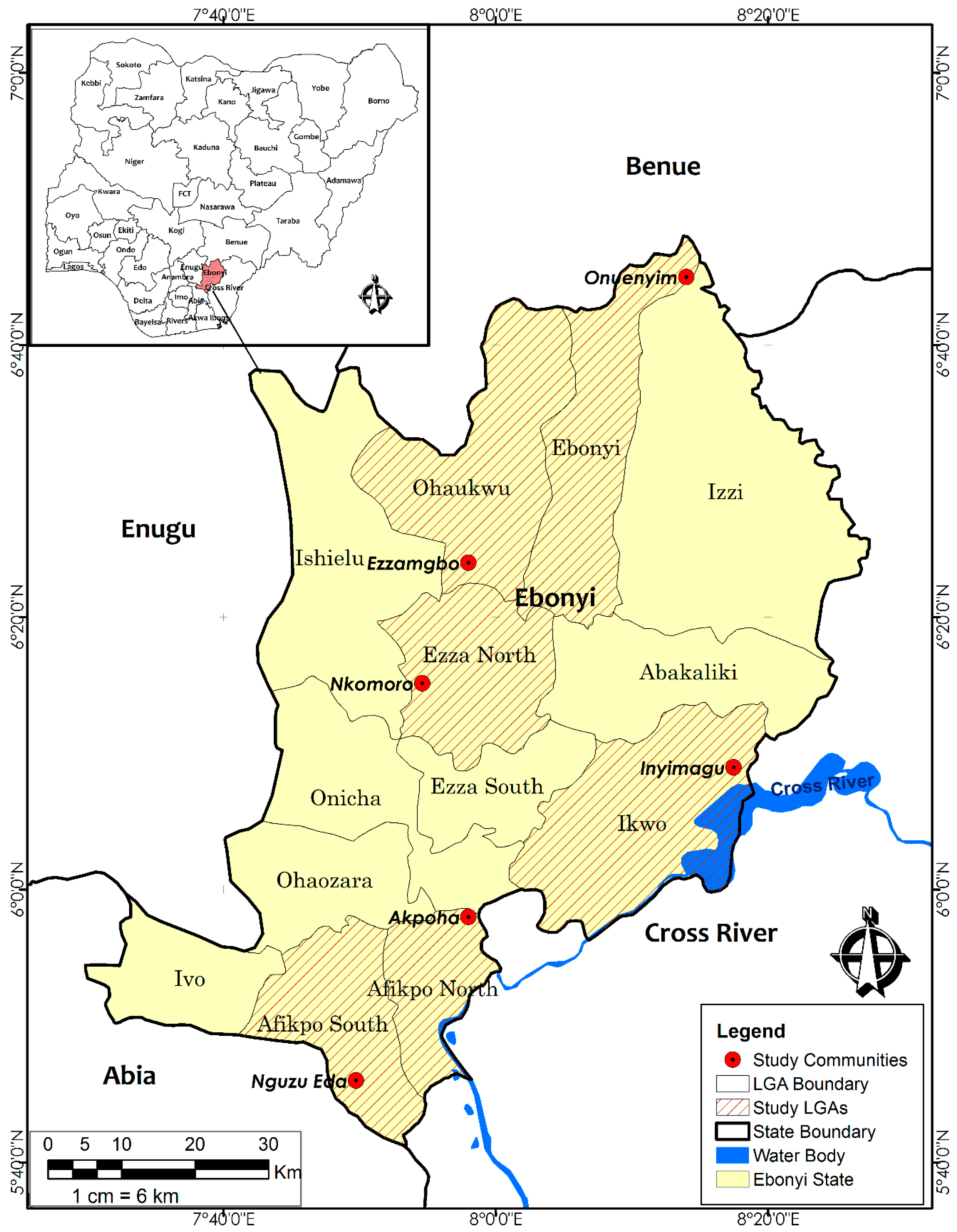
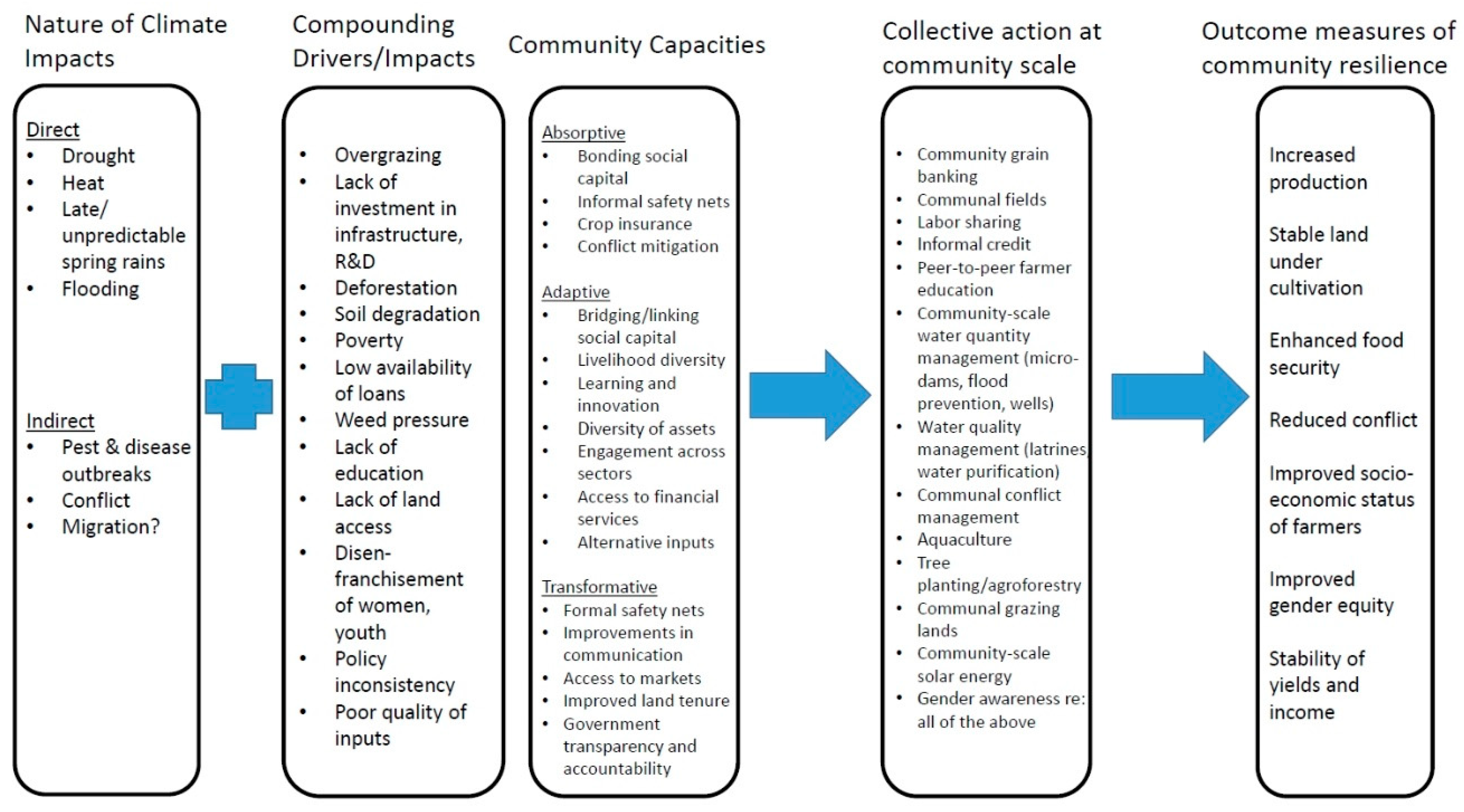
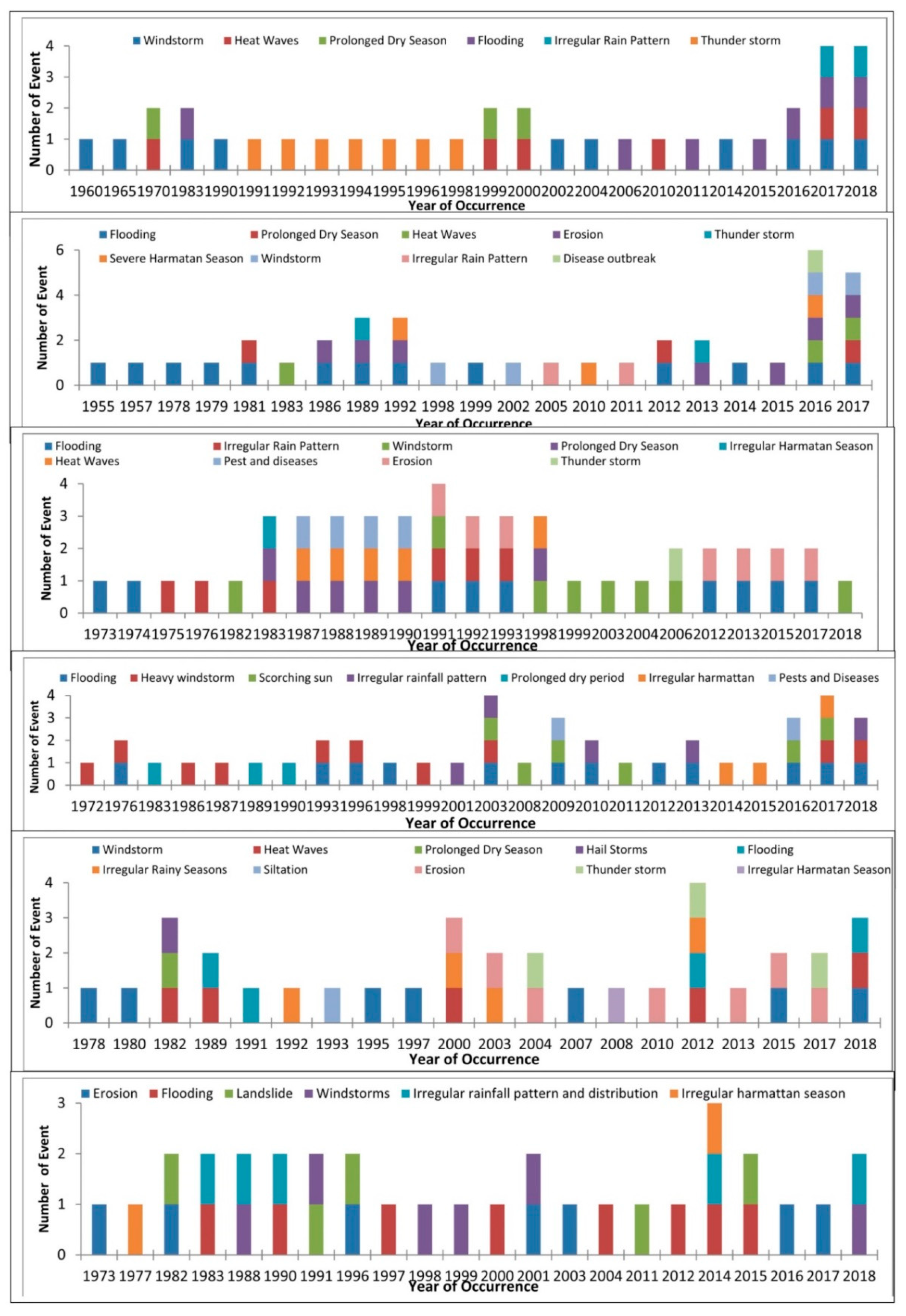
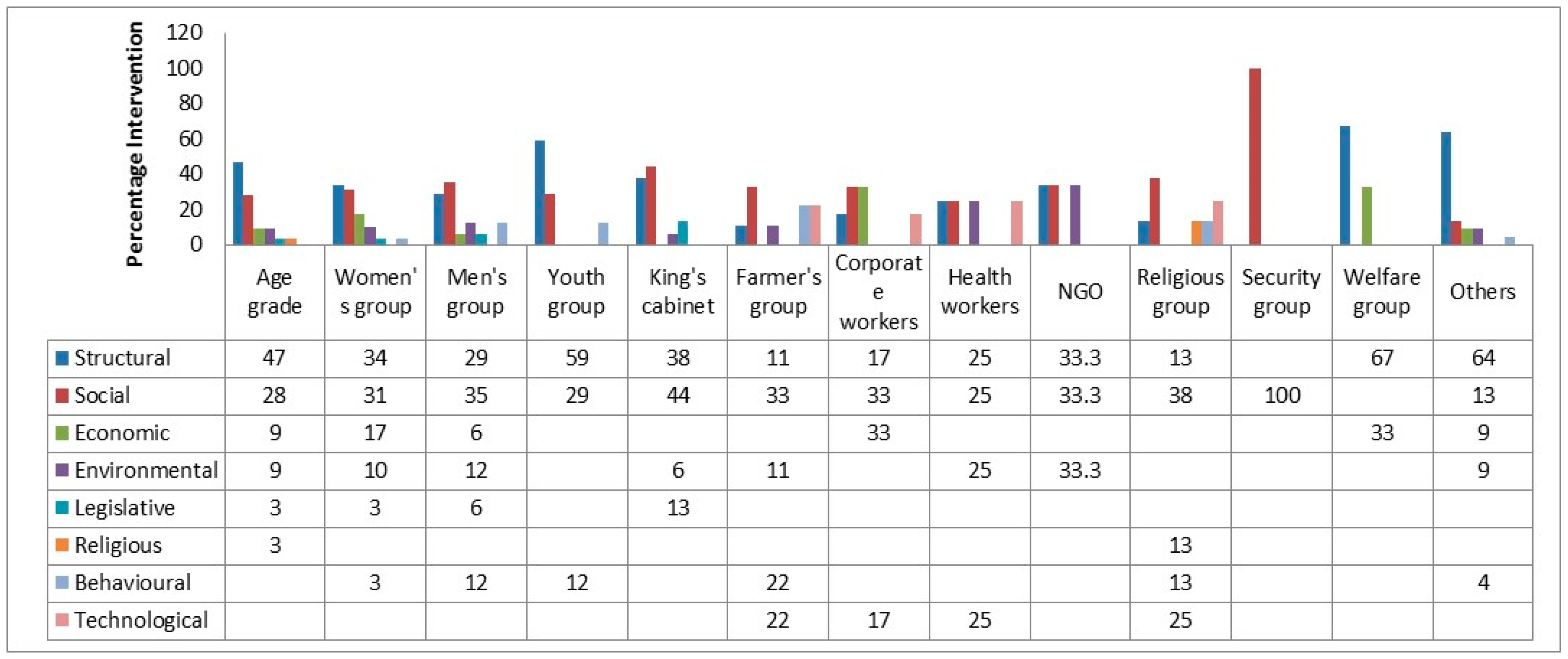
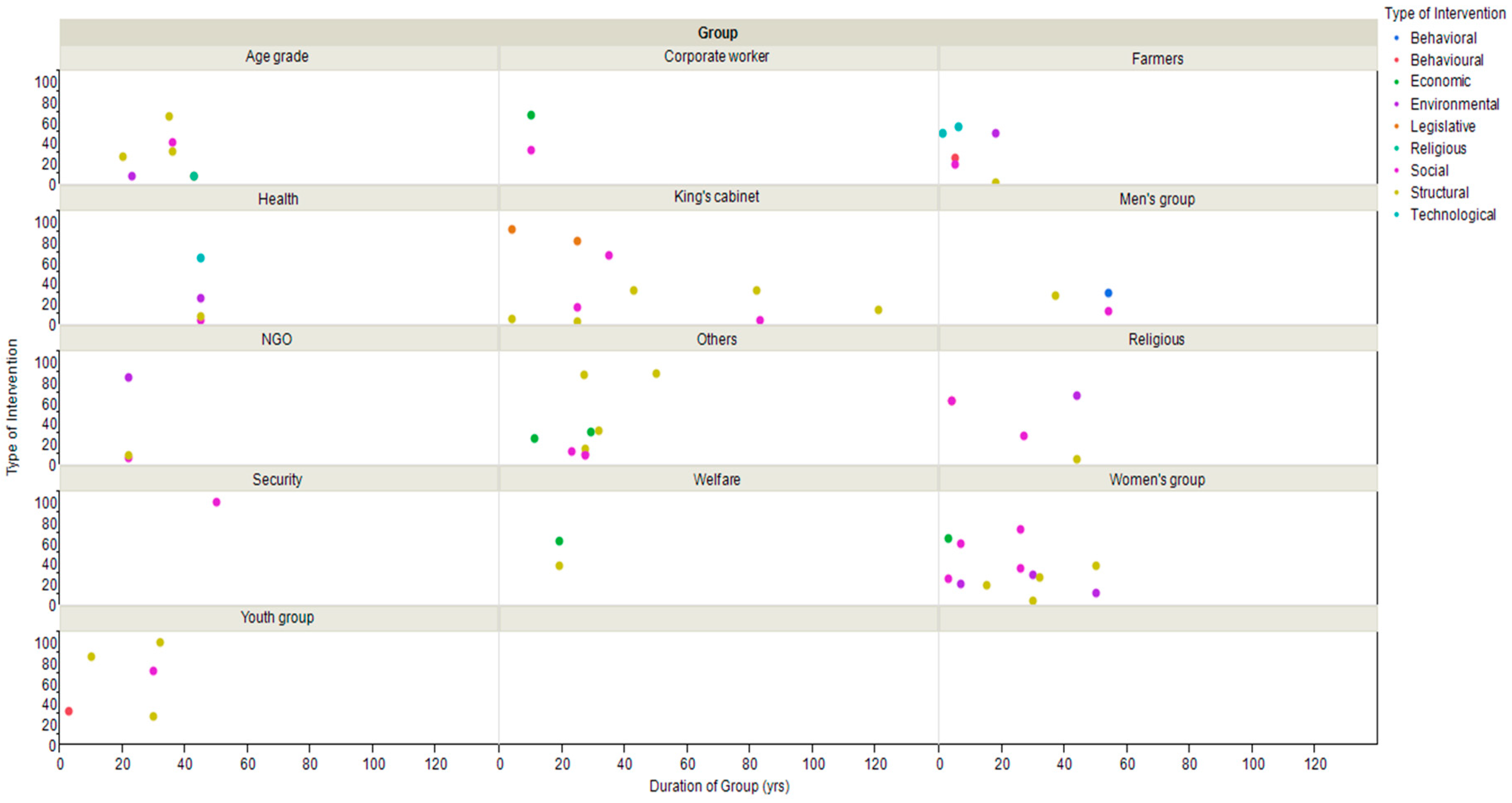
| Community | Timeline Participants | FGD Participants | Interview Participants | Total Number of Persons Interviewed |
|---|---|---|---|---|
| Akpoha | 61 | 20 | 30 | 111 |
| Ezzamgbo | 68 | 20 | 23 | 111 |
| Onueyim | 288 | 20 | 32 | 340 |
| Inyimagu | 105 | 20 | 30 | 155 |
| Nguzu–Edda | 53 | 20 | 37 | 110 |
| Nkomoro | 52 | 20 | 35 | 107 |
| Total | 627 | 120 | 187 | 934 |
| Name |
|---|
| Adaptation techniques |
| Decision to adapt |
| Duration of organization |
| Future perception |
| Gains from adaptation mechanism |
| History of climate change events |
| Membership capacity |
| Quality of mechanism |
| Status of adaptation mechanism |
| Type of organization |
| Intervention Type | Ezz | Onu | Nko | Iny | Akp | N-E | Pooled |
|---|---|---|---|---|---|---|---|
| Structural | 7 (40%) | 11 (36%) | 11 (50%) | 26 (58%) | 19 (40%) | 11 (65%) | 85 (47%) |
| Behavioral | 3 (17%) | 2 (7%) | 1 (4%) | 2 (4%) | 1 (2%) | 0 (0%) | 9 (5%) |
| Social | 3 (17%) | 9 (30%) | 5 (22%) | 9 (20%) | 14 (30%) | 2 (12%) | 42 (24%) |
| Economic | 2 (11%) | 3 (10%) | 2 (9 %) | 4 (9%) | 1 (2%) | 3 (18%) | 15 (8%) |
| Environ. | 1 (5%) | 2 (7%) | 1 (4%) | 4 (9%) | 8 (17%) | 1 (6%) | 17 (10%) |
| Legislative | 1 (5%) | 1 (3%) | 1 (4%) | 0 (0%) | 1 (2%) | 0 (0%) | 4 (2%) |
| Tech. | 1 (5%) | 2 (7%) | 1 (4%) | 0 (0%) | 1 (2%) | 0 (0%) | 5 (3%) |
| Religious | 0 | 0 (0%) | 0 (0%) | 0 (0%) | 2 (4%) | 0 (0%) | 2 (1%) |
| Total | 18 (100%) | 30 (100%) | 22 (100%) | 45 (100%) | 47 (100%) | 17 (100%) | 179 (100%) |
| Group | Incidence | Year | Intervention | Quality |
|---|---|---|---|---|
| King’s cabinet | Flooding | Creation of water channels, salvaging of crops in the field during flooding, financial contributions to victims, growing adaptive crops (rice) on flood-prone lands, and road maintenance and bridge repair | E | |
| Flooding | Advising community members to avoid building and planting in flood-prone area | I | ||
| Age grade | Flooding/Prolonged dry season/Windstorm | 1970; 1982; 1983; 1989; 1990; 1991; 2017; 2018 | Construction of bridges and culverts, road maintenance, built embankments, security patrols, and rehabilitated damaged buildings | E |
| erosion/Windstorm | 2014 | Construction of bridge; filling eroded paths, clearing water ways | I | |
| Others | Erosion/Flooding/ Irregular rainy season/Prolonged dry season/windstorm/ Pests diseases | 1991; 2012; 2015; 2016; 2017; 2018 | Rebuilding damaged structures; repairing and maintaining roads, bridges, and culverts; financial and labor contributions and providing relief materials to victims; making courtesy visits to the caretakers of the community; advisory roles; sensitizing people to weather/climate forecasts; discouraging cultivation on lands prone to flooding; group work in farms of flood victims; dry season farming; introduction of early maturing crop varieties | E |
| Others | Erosion | Communal road repairs, road maintenance, and reclamation | I | |
| Farmer’s group | Flooding | Trained members on farming implements, improved faming systems and warning signs; advisory services on climate reports; avoiding farming in flood prone areas; early planting/early maturing varieties; and use of metrological information | E | |
| Youth group | Erosion/Flooding | Clearing of the roads and pathways, construction of bamboo bridges, construction of boats/ferries to help people reach their farm plots and salvage some crops during the flooding, and alternating farmlands for cultivation based on season | I | |
| Womens’ group | Erosion/Windstorm/Flooding | Provision of relief materials; road repairs and maintenance; house repair; and labor and financial contributions towards repairing eroded roads | E | |
| Men’s group | Erosion | Repairing and maintaining road and bridge | E | |
| Corporate workers | Flooding/Scorching sun | Provision of monetary relief by the state government | I | |
| Religious group | Flooding | Dry season/irrigation farming | E |
© 2019 by the authors. Licensee MDPI, Basel, Switzerland. This article is an open access article distributed under the terms and conditions of the Creative Commons Attribution (CC BY) license (http://creativecommons.org/licenses/by/4.0/).
Share and Cite
Choko, O.P.; Schmitt Olabisi, L.; Onyeneke, R.U.; Chiemela, S.N.; Liverpool-Tasie, L.S.O.; Rivers, L., III. A Resilience Approach to Community-Scale Climate Adaptation. Sustainability 2019, 11, 3100. https://doi.org/10.3390/su11113100
Choko OP, Schmitt Olabisi L, Onyeneke RU, Chiemela SN, Liverpool-Tasie LSO, Rivers L III. A Resilience Approach to Community-Scale Climate Adaptation. Sustainability. 2019; 11(11):3100. https://doi.org/10.3390/su11113100
Chicago/Turabian StyleChoko, Onyinye Prince, Laura Schmitt Olabisi, Robert Ugochukwu Onyeneke, Stella Nwawulu Chiemela, Lenis Saweda O. Liverpool-Tasie, and Louie Rivers, III. 2019. "A Resilience Approach to Community-Scale Climate Adaptation" Sustainability 11, no. 11: 3100. https://doi.org/10.3390/su11113100
APA StyleChoko, O. P., Schmitt Olabisi, L., Onyeneke, R. U., Chiemela, S. N., Liverpool-Tasie, L. S. O., & Rivers, L., III. (2019). A Resilience Approach to Community-Scale Climate Adaptation. Sustainability, 11(11), 3100. https://doi.org/10.3390/su11113100





